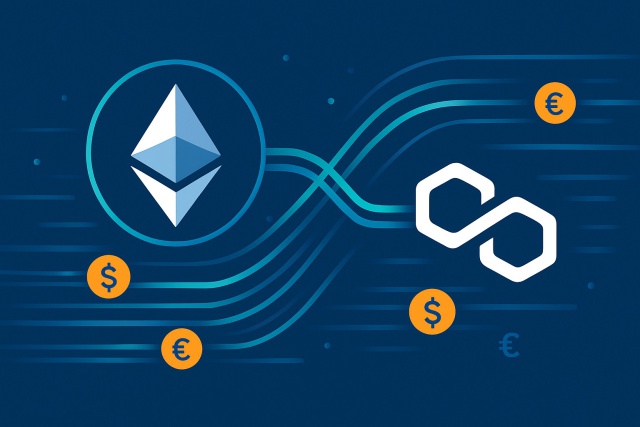What Is Sui?


If you're wondering what is Sui, it's an innovative altcoin and a next-generation blockchain platform designed to tackle the pesky scalability and decentralization challenges that have been tripping up many current blockchains.
Understanding the Basics: What is Sui?
Sui is a decentralized layer-1 blockchain platform designed to deliver fast and scalable budget-friendly transactions. It has a unique architecture that seriously cranks up transaction speed and capacity, making it stand out.
- Sui is a layer-1 blockchain that handles the nitty-gritty of transaction processing and consensus behind the scenes.
- Its native token aptly named SUI pulls double duty for fees, staking and even governance.
- The platform uses a unique consensus mechanism that mixes Narwhal with Byzantine Fault Tolerance to be both robust and reliable.
- Sui zeroes in on practical use cases like DeFi, NFTs, gaming and enterprise applications where it really shines.
- The goal is to attract developers and users who want blockchain solutions that are fast, scalable and won’t break the bank.
A Closer Look at the Technology Behind Sui
Sui’s technology revolves around a rather unique consensus protocol paired with an object-focused data model. Picture the blockchain juggling thousands of individual digital objects, each one growing and evolving on its own terms. This clever arrangement not only keeps processing neat and tidy but also lets a ton of actions happen simultaneously.
Move Programming Language: Originally crafted for Diem this secure and flexible language found a new home writing smart contracts and on-chain modules on Sui. It gives your code a sturdy yet nimble toolbox.
Object-Centric Data Model: Rather than the old-school way of updating a single global state with every transaction, Sui treats each asset as its own unique digital object that can be tweaked independently. Everyone has their own little sandbox to play in.
Narwhal Consensus Mechanism: It cleverly amps up efficiency by splitting the job of sharing transaction data from deciding the order those transactions happen to speed up cooking.
Byzantine Fault Tolerance (BFT): This nifty feature helps the network reach consensus even if some nodes misbehave or just flake out. It is like having a tough referee who won’t let a few bad apples spoil the whole game.
Parallel Transaction Processing: By keeping independent objects nicely separated, Sui can juggle multiple transactions at once and significantly crank up speed and throughput. It’s a bit like running several lanes on a highway instead of one slow, jammed-up road.
Think of these components as a well-oiled workshop where a bunch of skilled craftsmen each tackle their own piece of the puzzle without having to wait around for someone else to finish. This clever arrangement lets Sui zip through transaction confirmations in no time and juggle thousands per second.

What Really Sets Sui Apart From the Crowd of Altcoins?
Instead of sticking to Ethereum's account model or Solana's proof-of-history system, Sui opts for a fresh object-centric approach paired with a distinctive consensus design. This clever combo helps it punch above its weight in scalability while keeping decentralization intact.
| Feature | Sui | Ethereum | Solana | Avalanche |
|---|---|---|---|---|
| Consensus Type | Narwhal combined with BFT, a clever blend that keeps things both fast and secure | Proof of Stake, the tried-and-true method that is stood the test of time | Proof of History teamed up with PoS, making time itself part of consensus magic | Avalanche Consensus, known for its unique approach that’s shaking things up |
| Transaction Speed | Can comfortably handle thousands per second — a real speedster in the blockchain world | Around 15 to 30 TPS, not lightning fast but reliable for many use cases | About 5,000 TPS, packing a serious punch when it comes to speed | Roughly 4,500 TPS, holding its own with impressive throughput |
| Scalability Approach | Focused on objects and parallel transactions, which basically means it multitasks like a champ | Leverages Layer 2 solutions like Rollups to ease the load, clever layering if you ask me | Relies on a high-throughput validator network, designed to keep things moving at a brisk pace | Uses subnets with multiple chains, spreading the work across the network with finesse |
| Programming Language | Move, fresh and designed to keep things safe and efficient | Solidity, the veteran language that many developers swear by | Rust and C, bringing performance and control to the table with a bit of old-school charm | Solidity, again proving its popularity in the smart contract arena |
| Ecosystem Focus | Has its sights set on DeFi, NFTs, gaming, and enterprise — a versatile player ready for action | Supports a wide range of dApps and DeFi, making it the Swiss Army knife of platforms | Built for high-speed applications and DeFi, perfect for when every millisecond counts | Concentrates on DeFi and finance platforms, zeroing in on where the money talks happen |
This table makes it pretty clear that while Ethereum still leads the pack in ecosystem size and Solidity use, Sui throws a fresh spin into the mix with Move and an architecture designed from the ground up to seriously boost scalability. Solana goes all-in on ultra-high speed though that comes with its own set of trade-offs while Avalanche plays the flexible card with adaptable subnets.
Real-World Applications and Practical Uses of Sui
Sui is not just a shiny concept tossed around in tech circles. It’s carving out a solid spot in the real world, turning heads with practical applications that matter. From streamlining smart contracts to jazzing up blockchain gaming experiences, Sui is proving it’s got the chops to handle serious business. And let me tell you, it’s about making life easier, faster, and maybe even a bit more fun, depending on where you look. So buckle up, because we’re diving into how Sui is making waves beyond the theoretical, putting its tech muscle into everyday use cases that could very well be the future knocking on our door.
Sui really shines when it comes to practical uses especially in situations where quick transactions and keeping costs low are a must. Its design effortlessly supports everything from DeFi protocols to lightning-fast micro-payments in gaming. Plus, it handles feature-packed NFT platforms and complex enterprise applications that demand smooth and efficient data management.
- Enabling lightning-fast micro-payments and asset swaps within blockchain-based games, making transactions feel almost instant.
- Supporting scalable NFT marketplaces where a flurry of token transfers can happen simultaneously, without breaking a sweat.
- Running smart contracts for decentralized finance apps in a way that’s not just efficient, but also rock-solid secure.
- Powering data-heavy applications that cleverly leverage Sui’s object-centric data model to effortlessly handle complex states.
These use cases cleverly tap into Sui's parallel processing and unique consensus mechanism to slash transaction costs and speed things up, making blockchain applications not just more practical but also a bit friendlier to use—whether you are a consumer or a big enterprise.
Getting Started with Sui
Alright, let us dive right in and get you up to speed with Sui. Whether you’re a complete newbie or just brushing up, this section will walk you through the essentials without any jargon overload. So, buckle up—it's easier than you might think, and I’ll be here to make sure you don’t get lost along the way.
Getting started with Sui is surprisingly straightforward. New users can easily set up wallets that work well with the platform, grab some SUI tokens on exchanges, explore decentralized applications, dive into staking or governance and stay in the loop with official updates.
Pick and set up a Sui-compatible wallet such as Sui Wallet or another popular option that works well with the network.
Snag some SUI tokens from trusted exchanges where they’re available and keep your transactions secure.
Link your wallet to get involved with Sui-based dApps for gaming, DeFi or browsing NFT marketplaces.
Think about staking your SUI tokens or joining governance activities. It’s a great way to help steer the network’s future.
Keep an eye on official Sui social media channels, forums and blogs so you’re always updated with the latest news and features.
Keep your assets safe and sound by sticking to official wallets and always double-checking those URLs before you connect. Never share your private keys or seed phrases—they are like the crown jewels of your digital kingdom. Watch out for phishing scams as they can be very sneaky. If you’re just starting out, try using small token amounts first so you can get the lay of the land without stress. Keeping your wallet software up to date is like giving it a fresh coat of armor that boosts your security.
Frequent Misunderstandings About Sui That Almost Everyone Trips Over
There are a few common misconceptions floating around about Sui. Some people assume it’s designed solely for developers, while others end up mixing it up with other projects that happen to share similar names. People also often jump to the conclusion that decentralization means slower speeds or worry that its cutting-edge technologies might somehow compromise security.
- Sui packs in user-friendly features that open the door for more than just hardcore developers. It offers simple wallets and a steadily growing dApp ecosystem that is starting to feel like home for a wider crowd.
- It stands out as a truly unique project and should not be confused with other blockchain efforts that might share a similar name. It has its own distinct flavor.
- When it comes to security, Sui doesn’t mess around. It relies on time-tested cryptographic techniques and robust consensus methods like Byzantine Fault Tolerance to keep things locked down tight.
- Impressively, it scales up without losing its soul by managing to keep decentralization intact while balancing network speed with the kind of reliability and trust users have come to expect. This is no small feat.
"Think of Sui as the clever traffic cop in a jam-packed city, not by building new roads but by tweaking those pesky intersections so cars glide through without the usual snail’s pace. That’s exactly how Sui takes on blockchain slowdowns, quietly shaking up the notion that blockchains must be slow and pricey."
What Lies Ahead for Sui
Sui’s roadmap zeroes in on boosting network decentralization and rolling out sturdier developer tools. It also expands support for the broader ecosystem.
For those wondering what is Sui, the community really rolls up its sleeves when it comes to shaping the network by diving into open-source collaboration and sharing feedback that keeps the momentum going. Developer grants and partnerships are pulling in seriously talented builders and speeding up innovation like a well-oiled machine. As blockchain adoption spreads like wildfire, Sui seems poised to carve out a leading role by balancing speedy, scalable tech with core decentralization values we all care about.
Frequently Asked Questions
How does Sui achieve faster transaction speeds compared to Ethereum or Solana?
Sui uses an object-centric data model and handles transactions in parallel so many independent transactions can happen at once without interfering with each other. Unlike Ethereum’s slow one-at-a-time approach or Solana’s proof-of-history, Sui’s Narwhal consensus with a Byzantine Fault Tolerance system avoids traffic jams. The result is thousands of transactions per second with impressively low latency—pretty slick.
Is Sui suitable for beginners, or is it only for developers?
While Sui offers a powerful toolkit for developers, it does not leave newcomers out. Thanks to user-friendly wallets, straightforward documentation, and a growing crowd of dApps, beginners can jump in without breaking a sweat. Getting SUI tokens, interacting with apps or staking is surprisingly approachable even if you’re not knee-deep in code.
What makes Sui’s Move programming language unique?
Move was originally crafted for Diem (formerly Libra) with a focus on security and flexibility for smart contracts. Its resource-oriented design avoids common pitfalls like reentrancy attacks, which is why it’s popular for DeFi and NFT projects. Sui’s version of Move adds scalability thanks to the clever object-centric model. It’s like Move got a turbo boost.
Can Sui handle complex applications like enterprise systems or high-frequency gaming?
Absolutely. Sui performs well in data-heavy environments. It powers micro-payments in gaming, maintains solid state management for enterprises, and handles high-octane DeFi workloads. With parallel processing and wallet-friendly fees, it’s a natural choice for real-time large-scale applications where speed and cost matter.
How secure is Sui’s blockchain given its novel consensus mechanism?
Sui combines Narwhal’s efficient data handling with the tried-and-true Byzantine Fault Tolerance consensus. This solid combination keeps things safe even when some nodes act up or go offline. Built on a strong cryptographic foundation, it balances scalability with security. So far, faster does not mean riskier in this case.
Where can I buy SUI tokens, and which wallets support them?
You can find SUI on major exchanges like Binance, Coinbase and Kraken. For storing tokens, the official Sui Wallet is your best bet but alternatives like Trust Wallet also work. A little advice: always double-check links to avoid scams and start small when testing transactions—better safe than sorry!
Start Your Crypto Journey with Coinbase Today
Ready to enter the cryptocurrency market but unsure where to begin? Coinbase makes buying, selling, and storing digital assets simple and secure for beginners and experts alike.








